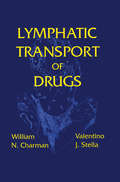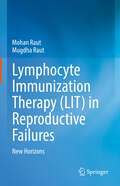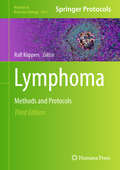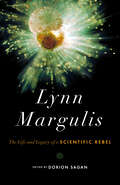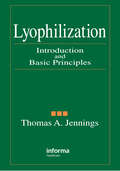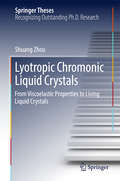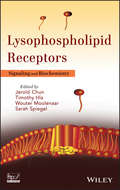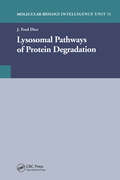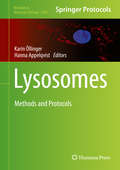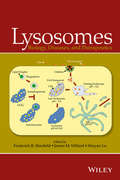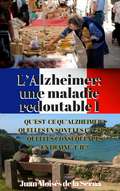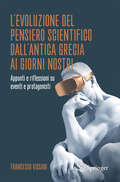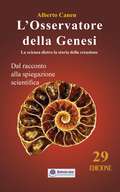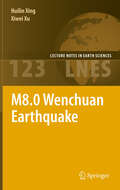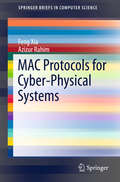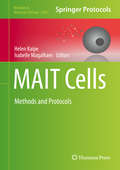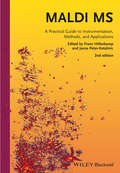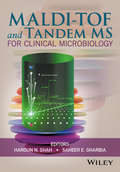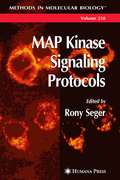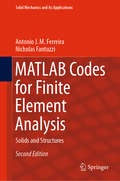- Table View
- List View
Lymphatic Transport of Drugs
by William N. CharmanLymphatic Transport of Drugs provides a thorough review of the determinants that affect the uptake and delivery of drugs and xenobiotics to the lymphatics. Factors affecting the transport and delivery of lipophilic drugs through the lymph after oral administration, lymphatic transport of polar drugs and macromolecules after gastrointestinal dosing, transport of drugs into the lymph after parenteral administration, and particulate drug delivery systems are among the topics examined in this volume. Lymphatic Transport of Drugs is primarily intended for pharmaceutical scientists who are attempting to alter the delivery of current therapeutic agents through formulation of prodrugs, as well as for researchers designing new drugs for lymph delivery.
Lymphocyte Immunization Therapy (LIT) in Reproductive Failures: New Horizons
by Mohan Raut Mugdha RautRecurrent Miscarriages (RM) & Implantation Failure (IF) have remained an enigma to clinicians and researchers. Even after ruling out all possible causative factors, 50-60% cases still remain “Unexplained’. A majority of these so called “Unexplained” cases are now found to have immunological basis.This book is going into the Immunological aspects of these clinical dilemmas, demystifying the role of Immunology and Immunotherapy in RM and IF. The authors have been working in the field of Reproductive Immunology and Immunotherapy for the last 25 years and they have come out with this book combining the international studies with their own experience. The purpose of writing this book is to provide a comprehensive treatise about Immunotherapy, so that it can become an acceptable modality of treatment in cases where it is needed and is effective.The book discusses the basics in Reproductive Immunology. The immunological changes occurring during pregnancy, the role of Cell mediated Immunity (T cells), Humoral Immunity including cytokines is explained. The normal immunological mechanisms protecting the embryo are highlighted and how these mechanisms are disturbed leading to RM and IF, is also explained.The first and the most discussed method of Immunotherapy is Lymphocyte Immunization Therapy (LIT). The book has given a complete overview of LIT, describing how it created euphoria when it was first introduced, how it gradually went into disrepute and how it is now making a comeback. As the authors have personal experience of LIT, the book gives a detailed and complete information about this active form of immunotherapy.The book has a special section on case studies where the authors have given some clinical case reports (including some of their own), who were treated for immunological factor in RM/IF and were treated with Immunotherapy. These cases can be a useful guide to the readers.The book will be useful not only for undergraduate and postgraduate students but also for clinicians in their practice and for researchers for review of developments in the field.
Lymphoma
by Robert Marcus Robert Marcus John W. Sweetenham Michael E. Williams John W. SweetenhamMajor advances have occurred in the diagnosis and treatment of lymphoma in recent years. Our understanding of the molecular biology and genetics of the disease has increased exponentially, and significant imaging developments have resulted in earlier and more accurate diagnosis. The new edition of this landmark text places these advances in the context of daily clinical practice. Each chapter has been updated to reflect recent developments, including new treatment agents such as immunomodulatory drugs and the next generation of antibodies, and the increasing prognostic role of PET scanning. Results from recent large-scale clinical trials are presented, and pathology and cytogenetics are integrated into discussion of each disease entity, enabling the reader to review all the key diagnostic information in one place. Featuring many color illustrations, and written and edited by leading authorities in the field, Lymphoma provides all the information you need to diagnose and manage these complex disorders.
Lymphoma: Methods and Protocols (Methods in Molecular Biology #2865)
by Ralf KüppersThis detailed volume expands upon the previous edition with key methods currently used in lymphoma research, partly specific for lymphoma research but often adaptable to the study of other cancers. New chapters explore the latest approaches for single cell B cell and T cell receptor sequencing, multiplexed immunophenotyping of lymphoma tissue samples, genetic manipulation and extended culture of human germinal center B cells, genetic mouse models of lymphomas, establishment of patient-derived xenograft models of lymphomas, and more. Written in the highly successful Methods in Molecular Biology series format, chapters include introductions to their respective topics, lists of the necessary materials and reagents, step-by-step and readily reproducible laboratory protocols, and tips on troubleshooting and avoiding known pitfalls. Authoritative and up-to-day, Lymphoma: Methods and Protocols, Third Edition serves as a valuable resource for hematologists, hematopathologists, and scientists interested in a variety of topics in cancer research, human genetics, and immunology.
Lynn Margulis: The Life and Legacy of a Scientific Rebel
by Dorion SaganTireless, controversial, and hugely inspirational to those who knew her or encountered her work, Lynn Margulis was a scientist whose intellectual energy and interests knew no bounds. Best known for her work on the origins of eukaryotic cells, the Gaia hypothesis, and symbiogenesis as a driving force in evolution, her work has forever changed the way we understand life on Earth.When Margulis passed away in 2011, she left behind a groundbreaking scientific legacy that spanned decades. In this collection, Dorion Sagan, Margulis's son and longtime collaborator, gathers together the voices of friends and colleagues to remark on her life and legacy, in essays that cover her early collaboration with James Lovelock, her fearless face-off with Richard Dawkins during the so-called "Battle of Balliol" at Oxford, the intrepid application of her scientific mind to the insistence that 9/11 was a false-flag operation, her affinity for Emily Dickinson, and more.Margulis was elected to the National Academy of Sciences in 1983, received the prestigious National Medal of Science in 1999, and her papers are permanently archived at the Library of Congress. Less than a month before her untimely death, Margulis was named one of the twenty most influential scientists alive - one of only two women on this list, which include such scientists as Stephen Hawking, James Watson, and Jane Goodall.&“Although she could be a bulldog, her heart was soft and her spirit loving beneath the scientific realpolitik of her conversation and the insistent tough-mindedness of her sometimes strident and blunt, withering and refreshingly unadorned opinions.&”—Dorion Sagan, from the introduction
Lyophilization: Introduction and Basic Principles
by Thomas A. JenningsFinding consistent, analytical discussions of processes and principles of lyophilization can be challenging and often frustrating. The first resource to gather information about the field, Lyophilization: Introduction and Basic Principles is still the book to have on lyophilization. Presenting information in an easy-to-read style, the book comprehe
Lyotropic Chromonic Liquid Crystals
by Shuang ZhouThis thesis describes lyotropic chromonic liquid crystals (LCLCs) with exotic elastic and viscous properties. The first part of the thesis presents a thorough analysis of the elastic and viscous properties of LCLCs as functions of concentration, temperature and ionic contents, while the second part explores an active nematic system: living liquid crystals, which represent a combination of LCLC and living bacteria. LCLCs are an emerging class of liquid crystals that have shown profound connections to biological systems in two aspects. First, the assembly process of the chromonic aggregates is essentially the same as DNA oligomers and other super-molecular assemblies of biological origin. LCLCs thus provide an excellent model system for studying physical properties such as the elasticity and viscosity of these supramolecular assemblies. Second, LCLCs are biocompatible, thus serving as a unique anisotropic matrix to interface with living systems such as bacteria. This thesis deepens our understanding of both aspects. The noncovalent nature of chromonic aggregation produces the unique viscoelasticity to be found in LCLCs, which differs dramatically from that of traditional LCs. Anisotropic interactions between LCLCs and bacteria lead to fascinating phenomena such as the deformation of LCLCs with a characteristic wavelength determined by the elasticity of the LCLCs and the activity of the bacteria, orientationally controlled trajectories of bacteria and visualization of 24 nm flagella motion.
Lysenko's Ghost: Epigenetics and Russia
by Loren GrahamLysenko became one of the most notorious figures in twentieth-century science after his genetic theories were discredited decades ago. Yet some scientists now claim that discoveries in epigenetics prove that he was right after all. Loren Graham reopens the case, to determine whether new developments in molecular biology validate Lysenko's claims.
Lysophospholipid Receptors
by Wouter Moolenaar Timothy Hla Sarah Spiegel Jerold ChunThe current state of the science supporting new research in lysophospholipidsThe study of lysophospholipids exploded with the discovery of cell surface receptors on both lysophosphatidic acid (LPA) and sphingosine 1-phosphate (S1P). Since then, thousands of original research reports-ranging from fundamental cell signaling to the physiology and pathophysiology of individual organ systems-have centered on lysophospholipids. This book draws together and analyzes the current literature to provide readers with a state-of-the-science review as well as current techniques that support research in all aspects of the field of lysophospholipid signaling.Lysophospholipid Receptors is divided into three sections:Receptors and other possible effectorsEnzymesPhysiology and pathophysiologyWithin each section, the authors explain the similarities and differences between LPA and S1P signaling. Examples are provided that demonstrate the underlying mechanisms of lysophospholipid signaling across a broad range of organ systems, such as S1P signaling in cardiovascular physiology and disease and the neural effects of LPA signaling. Extensive references at the end of each chapter provide a gateway to the literature and facilitate further research into individual topics.Each chapter has been authored by one or more leading international authorities in lysophospholipid research. Based on a thorough analysis of the current research, the authors set forth what is established science and offer their expert opinion and perspective on new and emerging areas of research, setting the stage for further investigations that will solve current problems in the field.
Lysosomal Pathways of Protein Degradation
by J Fred DiceLysosomal Pathways of Protein Degradation looks at cell biology from the view of a lysosome. It summarizes the composition and assembly of lysosomes in mammalian and yeast cells. It also reviews current knowledge about pathways of endocytosis and secretion and how both endocytosed and secreted proteins can be delivered to lysosomes for degradation.
Lysosomes
by Karin Öllinger Hanna AppelqvistThis volume provides laboratory protocols essential for studies on lysosomal biology. Chapters aim to guide researchers in their exploration of lysosomes, both under normal conditions and in pathological processes. Written in the highly successful Methods in Molecular Biology series format, chapters include introductions to their respective topics, lists of the necessary materials and reagents, step-by-step, readily reproducible laboratory protocols, and tips on troubleshooting and avoiding known pitfalls. Authoritative and practical, Lysosome: Methods and Protocols aims to provided protocols that will guide and inspire further research and generate new insights into this fascinating organelle.
Lysosomes: Biology, Diseases, and Therapeutics
by Shuyan Lu James M. Willard Frederick R. MaxfieldDiscussing recent findings, up-to-date research, and novel strategies, the book integrates perspectives from pharmacology, toxicology, and biochemistry to illustrate the potential of lysosomes in drug discovery and development.* Explores basic principles and properties of lysosomes that allow them to act as regulators of cell metabolism, therapeutic targets, and sites for activation of drug conjugates * Discusses the role of lysosomes in metabolism, drug targeting, apoptosis, cancer, aging, inflammation, autophagy, metabolism, toxicity, and membrane repair* Introduces new pathways in therapeutic development and new mechanisms in drug development
L’Alzheimer: une maladie redoutable I
by Juan Moises de la Serna Bakrim NouryIssu d’une trilogie amplement consacrée à la maladie Alzheimer, ce livre a été conçu à la base de questionnements utiles. D’emblée un mot sur ses mérites pédagogiques : le livre adopte une démarche rationnelle simplifiée qui permet à tous les lecteurs concernés de comprendre le phénomène qui les accable, partant ontologiquement de la définition très fine en passant par la causalité pour enfin aboutir aux conséquences variées. En outre, son intelligence se traduit par une articulation des questionnements ‘’populaires’’ aux grands questionnements de la recherche contemporaine sur l’Alzheimer. Pour l’avoir lu et traduit, je peux affirmer que cet équilibre est réussi. Le livre est aussi utile et fiable quand il s’agit de diversifier les références aux solutions thérapeutiques ou celles concernant les résultats de l’état de l’art actuel en matière d’Alzheimer : dans ce sens bien précis, les données sont exposées avec un sens aigu de la critique qui permet non seulement de comprendre ‘’ce qui se fait’’ aux quatre coins du monde mais aussi de pouvoir adopter une vision claire sur ‘’ce qui peut être concrètement fait’’ afin de retarder voire même de guérir la dégénérescence des fonctions cognitives de la mémoire. D’autres apports seront certainement un atout pour les lecteurs concernés ou curieux: la distinction d’Alzheimer des autres démences, où il propose même une forme de diagnostic enrichi, une nouvelle méthode de prévention/d’anticipation publique et familiale très utile pour les proches par exemple. L’accent mis sur l’inefficacité pharmacologique est une autre voie de vulgarisation où les lecteurs sauront comment se situer face aux traitements médicamenteux actuellement disponibles. Enfin, trois pistes sont suggérées où l’argumentation du livre culmine avec des propositions claires : la piste génétique, la piste biologique et la piste psycholo
L’evoluzione del pensiero scientifico dall’antica Grecia ai giorni nostri: Appunti e riflessioni su eventi e protagonisti
by Francesco VissaniLa scienza, come ogni cosa al mondo, ha avuto un inizio, un'origine. Sebbene non si possa stabilire con precisione il momento esatto degli esordi, il contributo della civiltà greca, come ampiamente attestato dai documenti, è stato cruciale; molti, tra cui l’autore, lo considerano essenziale per la nascita della scienza come la conosciamo. Il libro esplora l'evoluzione del pensiero scientifico con una raccolta di appunti e saggi che, procedendo in ordine cronologico ma senza seguire una struttura rigida, mantiene la lettura istruttiva e interessante. Si esaminano le prime forme assunte dalla scienza, la fioritura dell'ellenismo, la sua crisi e la sua rinascita, con particolare attenzione ai rapporti con la filosofia. Il viaggio inizia con i presocratici e i pitagorici, concentrandosi su Democrito, Platone e Archimede, e continua con un breve passaggio nell'era romana. Continua con il periodo arabo, per passare al Medioevo, con un riferimento a Dante; giunge infine al Rinascimento e ai pensatori moderni tra cui Galilei. Nell'ultima parte viene presentata la storia di alcune delle grandi scoperte della fisica, evidenziandone le relazioni con il pensiero antico; si conclude ragionando di situazioni contemporanee.
L’osservatore della Genesi
by Alberto Canen Aldo IngenitoPiù di 300.000 libri venduti! La scienza dietro la storia della creazione La Genesi, i sette giorni della creazione ... da dove viene il testo che costituisce la prima parte della Bibbia? Il suo testo è un semplice poema introduttivo ... o è una narrazione? Cosa c'è dietro le sue parole? Alberto Canen ha trovato un modo alternativo per rispondere a queste ed altre domande sulla Genesi. Ha trovato un percorso che nessuno altro aveva intrapreso prima, e invita il lettore a scoprirlo e condividere i suoi risultati con lui. L'autore ha scoperto che, nascosto sul fondo della trama, c'è qualcuno. Qualcuno che osserva. Qualcuno che racconta. Qualcuno che racconta quello che osserva. E un luogo, una posizione da cui egli osserva. La posizione dell'osservatore. La chiave di un puzzle emozionante. La Genesi è stata un mistero per migliaia di anni. Nessuno era riuscito mai a capire di cosa parlasse il testo, se era solo una poesia introduttiva alle Sacre Scritture, o conteneva in realtà informazioni sulla creazione. Il testo della Genesi ha separato le acque dei creazionisti e degli scienziati fino a oggi. Con questo libro spero di diluire questa separazione tra scienziati e creazionisti, poiché ho scoperto la chiave che unisce entrambi i mondi. Penso che la chiave per svelare il mistero della Genesi è capire che viene narrato da qualcuno. Un narratore della Genesi. Qualcuno che testimonia la visione che Dio gli dà e racconta ciò che ha visto, e lo vede dalla sua posizione umana e terrena. Questa precisa posizione terrena è la chiave per comprendere la Genesi.
M3 and M5 Stuart Light Tank, 1940-45
by Steven J. ZalogaThe M3 and M5 family of light tanks were the culmination of American tank development of the 1930s. By the time of the outbreak of the World War II, they were approaching obsolescence, as tank forces in Europe were shifting from light to medium tanks as the main element of their armored forces. First entering combat in the autumn of 1941 in the Western Desert with the British Army, the Stuart quickly proved its inadequacies. The M3 and M5 light tanks proved more suitable in the Pacific theater than in Europe, and fought successfully in many of the major battles including Guadalcanal, Tarawa and Peleliu. This title narrates this distinctive and unusual fighting vehicle's history.
M8.0 Wenchuan Earthquake
by Huilin Xing Xiwei XuThe M8.0 Wenchuan Earthquake occurred in China on May 12, 2008, killing over 69,000 people and displacing millions from their homes. This was one of the most catastrophic natural disasters on record. This book includes 5 chapters describing the tectonic setting and historical earthquakes around the Chuan-Dian region, the nucleation of the Wenchuan earthquake, occurrence and aftershocks. The field observations of earthquake induced surface fractures and building damage, form a major and special part of this book and include a large number of digital photos with accompanying explanantions.
MAC Protocols for Cyber-Physical Systems
by Feng Xia Azizur RahimThis book provides a literature review of various wireless MAC protocols and techniques for achieving real-time and reliable communications in the context of cyber-physical systems (CPS). The evaluation analysis of IEEE 802. 15. 4 for CPS therein will give insights into configuration and optimization of critical design parameters of MAC protocols. In addition, this book also presents the design and evaluation of an adaptive MAC protocol for medical CPS, which exemplifies how to facilitate real-time and reliable communications in CPS by exploiting IEEE 802. 15. 4 based MAC protocols. This book will be of interest to researchers, practitioners, and students to better understand the QoS requirements of CPS, especially for healthcare applications.
MAIT Cells: Methods and Protocols (Methods in Molecular Biology #2098)
by Helen Kaipe Isabelle MagalhaesThis volume focuses on various methods used by researchers to study mucosal-associated invariant T (MAIT) cells in the aspects described below. The chapters are organized into Four Parts: part One looks at the function and importance of MAIT cells in health and disease. It covers methods to isolate and characterize MAIT cells from human tissues including liver, colon tumors, placenta and decidua, and endometrium. Part Two discusses MR1 independent stimulation, and looks at the activation of MAIT cells by different stimulatory agents. Part Three describes various methods to develop tools to analyze, monitor, and generate MAIT cells in vitro, including the production of MR1-tetramers and how they can be loaded with bacterial antigens and used for the detection of MAIT cells. The last part covers the use of murine models to study MAIT cells. Written in the highly successful Methods in Molecular Biology series format, chapters include introductions to their respective topics, lists of the necessary materials and reagents, step-by-step, readily reproducible laboratory protocols, and tips on troubleshooting and avoiding known pitfalls.Authoritative and comprehensive, MAIT Cells: Methods and Protocols is a valuable resource for anyone interested in learning more about this developing field.Chapters 9 and 17 are open access under a CC BY 4.0 license.
MALDI MS
by Franz Hillenkamp Jasna Peter-KatalinicThis authoritative book on MALDI MS, now finally available in its second edition and edited by one of its inventors, gives an in-depth description of the many different applications, along with a detailed discussion of the technology itself.Thoroughly updated and expanded, with contributions from key players in the field, this unique book provides a comprehensive overview of MALDI MS along with itspossibilities and limitations.The initial chapters deal with the technology and the instrumental setup, followed by chapters on the use of MALDI MS in protein research (including proteomics), genomics, glycomics and lipidomics. The option of MALDI-MS for the analysis of polymers and small molecules are also covered in separate chapters, while new to this edition is a section devoted to the interplay of MALDI MS and bioinformatics.A much-needed practical and educational asset for individuals, academic institutions and companies in the field of bioanalytics.
MALDI-TOF and Tandem MS for Clinical Microbiology
by Saheer E. Gharbia Haroun N. ShahThis book highlights the triumph of MALDI-TOF mass spectrometry over the past decade and provides insight into new and expanding technologies through a comprehensive range of short chapters that enable the reader to gauge their current status and how they may progress over the next decade. This book serves as a platform to consolidate current strengths of the technology and highlight new frontiers in tandem MS/MS that are likely to eventually supersede MALDI-TOF MS. Chapters discuss:Challenges of Identifying Mycobacterium to the Species level Identification of Bacteroides and Other Clinically Relevant AnaerobesIdentification of Species in Mixed Microbial PopulationsDetection of Resistance MechanismsProteomics as a biomarker discovery and validation platformDetermination of Antimicrobial Resistance using Tandem Mass Spectrometry
MAP Kinase Signaling , 2nd Edition
by Rony SegerMitogen-activated protein (MAP) kinase (MAPK) cascades are key signaling components that govern essentially all cellular processes evoked by any type of stimulation, and it has been well established that the malfunctioning of these cascades leads to various diseases including cancer, autoimmunity, and diabetes. In MAP Kinase Signaling Protocols, Second Edition, expert researchers fully update the popular first edition the key techniques used in the study of MAPK signaling cascades in various cellular contexts. This thorough volume explores essential topics such as activation and function of components of the MAPK signaling cascades, the study of MAPK cascades as transmitters of membranal receptor signals, structure-function relationships of MAPKs, studies on the regulation of MAPK cascades, the use of lower organisms, animal models, and human genetics in the study of MAPKs, as well as the study of MAPKs in specific systems and diseases. Written in the highly successful Methods in Molecular Biology™ series format, chapters includes introductions to their respective subjects, lists of the necessary materials, step-by-step, readily reproducible laboratory protocols, and tips on troubleshooting and avoiding known pitfalls. Comprehensive and cutting-edge, MAP Kinase Signaling Protocols, Second Edition aims to facilitate the study of MAPKs and allow for quicker progress in our knowledge of many vital cellular processes as well as devastating diseases.
MAP Kinase Signaling Protocols
by Rony SegerAn outstanding collection of both classic and cutting-edge techniques for the detection and measurement of mitogen-activated protein kinase (MAPK) signaling cascades. The protocols includes methods for the determination of the subcellular localization of these components, the structural and biophysical analysis of the components, and identification of novel components of known and unknown signaling cascades. Additional methods examine the upstream mechanisms of activation of MAPK cascades by various receptors, the mechanisms involved in the down regulation of the MAPK cascades, and identification of targets of the MAPK cascades. A number of techniques use inhibitors in research on MAPK and transgenic mice for studies of MAPK signaling. The techniques offer biochemists, cell biologists, physicians, and biotechnologists all the essential laboratory techniques needed in to conduct productive studies of MAPK signaling in health and disease, in measuring the influence of drugs, and in a broad range of experimental systems.
MARINE 2011, IV International Conference on Computational Methods in Marine Engineering
by Eugenio Oñate Julio García-Espinosa Luís Eça Pål Bergan Trond KvamsdalThis book contains selected papers from the Fourth International Conference on Computational Methods in Marine Engineering, held at Instituto Superior Técnico, Technical University of Lisbon, Portugal in September 2011. Nowadays, computational methods are an essential tool of engineering, which includes a major field of interest in marine applications, such as the maritime and offshore industries and engineering challenges related to the marine environment and renewable energies. The 2011 Conference included 8 invited plenary lectures and 86 presentations distributed through 10 thematic sessions that covered many of the most relevant topics of marine engineering today. This book contains 16 selected papers from the Conference that cover "CFD for Offshore Applications", "Fluid-Structure Interaction", "Isogeometric Methods for Marine Engineering", "Marine/Offshore Renewable Energy", "Maneuvering and Seakeeping", "Propulsion and Cavitation" and "Ship Hydrodynamics". The papers were selected with the help of the recognized experts that collaborated in the organization of the thematic sessions of the Conference, which guarantees the high quality of the papers included in this book.
MATLAB Codes for Finite Element Analysis: Solids and Structures (Solid Mechanics and Its Applications #157)
by Nicholas Fantuzzi Antonio J. FerreiraThis book illustrates how MATLAB compact and powerful programming framework can be very useful in the finite element analysis of solids and structures. The book shortly introduces finite element concepts and an extensive list of MATLAB codes for readers to use and modify. The book areas range from very simple springs and bars to more complex beams and plates in static bending, free vibrations, buckling and time transient problems. Moreover, laminated and functionally graded material structures are introduced and solved.
